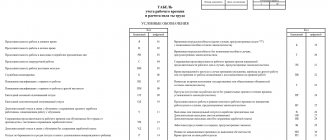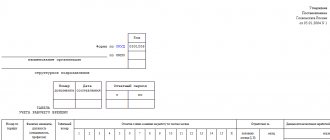The time sheet is intended for entering information about the time actually worked by employees of organizations. It must be said that the time sheet form is not strictly mandatory - in principle, it can be arbitrary, that is, each enterprise is free to use its own time sheet form if such a need arises. However, the form was developed and recommended for use by the State Statistics Committee of the Russian Federation and is preferable.
- Form and sample
- Free download
- Online viewing
- Expert tested
FILES
Who fills out the time sheet?
The form is filled out either by an employee of the HR department, or by the head of a structural unit, or by a timekeeper specially hired for this function. Based on the information entered into it, the accounting department specialists calculate wages and other payments to the organization’s employees. In fact, the time sheet is one of the most important accounting documents. And while small companies can easily do without it, large enterprises are required to keep such timesheets.
Depending on the personnel records system adopted at the enterprise, a time sheet can be generated either one for all employees of the organization, or maintained separately in each department.
The timesheet is a regular document, that is, a new copy must be compiled every month, so the serial number of the timesheet will be equal to the serial number of the month in which it was created. The timesheet preparation period covers all days of the month.
You can fill out the timesheet either electronically or in writing. However, after entering all the necessary information, it will still have to be printed for the signatures of the responsible persons.
Employee list management
Before you start entering data, you must delete test records by clicking the “Clear Timesheet”
.
After the cleaning procedure, an empty list will remain with the Total line, which, if necessary, can also be deleted by selecting any cell in the line and clicking the “Delete element”
. You can start entering from the first empty line.
Time sheet in excel 2021 has a number of useful functions for managing the employee list to make it easier to edit and more visual.
Use the "Add Group"
if you have a large staff and you want to divide the list into departments, or group employees by area of employment. Select any cell of the first empty row in which you want to place a line with the group name and click the corresponding button. The new group is added as a sublist title, so you must first add the new group and then enter the details of its members. The function is optional; the timesheet allows you to enter a list without groups if you are keeping a timesheet for personal accounting or you do not need to divide the list.
"Delete Item" function
deletes the row with the employee record or group header. Simply select any cell of the desired row and click the appropriate button. You can also use any standard Excel cleaning methods. Do not delete the entire row to avoid damaging data in neighboring tables.
"Add Entry" function
inserts an empty line between any list elements. For example, if you want to add a new employee to an already created list. Select any cell in the row where you want to insert a new record and click the corresponding button.
Form T-13. Shape Features
Let's start with the T-13 form, which is now used much more often for maintaining time sheets.
The unified form T-13 or electronic time sheet is well known to HR department employees. This is not the only way, but it is definitely the most standard way to account for hours worked. If you keep records manually, you should use Form T-12.
Timesheets are a common tool for tracking employee attendance. Form T-13 allows you to record in detail the reasons for absence from work, including student leave during the session, advanced training and several types of disability leave. The period for which the document is completed may be less than 31 days.
A completed T-13 is the basis for calculating wages.
Form T-13: appearance, filling, approval
The form consists of three blocks:
A cap. The name of the organization, its details, structural unit, and reporting period are indicated here.
Data table. The days of the month are arranged in two rows. Since, in addition to indicating the hours, you also need notes about the type of period (work, downtime, vacation, etc.), a sector of four lines is allocated for each employee.
Signatures. After filling out the report card, it is signed by the responsible executive, the head of the personnel department and the head of the enterprise.
How to fill out form T-13
After filling out the header, you must enter into the table all the timesheet employees and their personnel numbers. The basis for inclusion in the report card is the employment order. You can exclude a person from the report card only after signing an order for his dismissal.
| Documented justification is required for all times noted other than normal working hours. For example, a vacation period must be confirmed by a corresponding order, and sick leave must be confirmed by a certificate of temporary incapacity for work. |
When entering time data, the number of hours for each person is entered in the 2nd and 4th lines (in accordance with the dates). Lines 1 and 3 are for period codes. For example, “B” is a day off. Working day - “RW” or “I”. Pre-prepared forms are designed for 31 days, and if there are fewer dates in a particular month, then the extra ones must be crossed out with a cross.
We invite you to download the T-13 working time sheet with an example of filling it out for a 40-hour work week with a five-day work week.
Please note: the values for the duration of a regular working day must coincide with what the employee has specified in the employment contract. For most workers, an 8-hour working day is normal. But if the TD lists a shortened day, you cannot put “eights” on the report card.
| If a person worked overtime, this must be marked with a special code and the actual number of hours worked must be recorded. In this case, there must be an order from the manager to engage in overtime work. |
You can fill out the form using the continuous method (when all appearances and absences are noted) or you can register only deviations (lateness, overtime, no-show, etc.). If events are recorded in days, then you need to put a code in the upper cell and leave the lower one empty. Such events include business trips, sick leave, and vacations.
Procedure for keeping timesheets: approval
From January 1, 2013, unified forms of primary accounting, which include the RV accounting sheet, ceased to be mandatory and became recommended (Law No. 402-FZ of December 6, 2011). Because of this, the procedure for maintaining Form T-13 has become more flexible - each employer can add its own nuances to it. It is advisable to consolidate the procedure established in your company in a separate local act: manual or instruction. \
This is what needs to be reflected in this document:
- Who is responsible for maintaining the timesheet?
- Is it necessary to keep records for each division, or will registration be continuous for the company?
- Designations of time periods, if yours differs from the standard ones.
- Selected filling method (solid or only deviations).
- The procedure for reflecting emergency situations.
Format for filling out a working time sheet in T-13
Unlike arbitrary tables of similar content, T-13 contains data about the enterprise, including the form of ownership and OKPO. The document number is entered in accordance with internal requirements for maintaining timesheets.
The department name is also shown at the top. It must be remembered that the head of this department (even if filling out the time sheet is not his or her responsibility) must sign the completed form.
The order of employees is determined by the decision of the person in charge. Most often, alphabetical sorting is found, as in our example, but the option of arranging by personnel number is possible (column 3).
In column 4 we put marks by day:
I - (appearance) working day, B - day off, FROM - vacation, RP - attendance on a day off (working out), K - business trip, PC - advanced training, U - study leave with a call from an educational institution, B - sick leave with sick leave sheet, T - unpaid sick leave without sick leave.
Under the I mark we put the number of hours worked that day. In column 5 we summarize the number of I in the line and the number of hours. We get 4 values for 2 halves of the month. In column 6 we sum up the values and get the final figure for the work for the month.
The number of hours for B, OT, K, B and other cases is not indicated in the fourth column. For this there are columns 10-13.
Accounting for sick leave, vacations or absences for other reasons
Designation codes may be different (for example, numeric). There is no specific format required by law.
The notation X shows that we are not taking this day into account: for convenience, the month is divided into two lines with unequal values. For months with 30 days (for example, November, the column will look like this (for convenience, the “non-existent” 31st number is highlighted in red):
T-13 for November
By analogy, T-13 is filled out for visits in February.
Columns 7-9 indicate the payment code, number of days and type of charges. Our example uses the following codes:
- 2000 - Common workday,
- 2300 – sick leave (disability benefit),
- 2012 - vacation.
Alternative solution
Some enterprises approve a slightly simplified version of the time sheet without detailing the reasons for omissions. Column 4 indicates only 2 codes:
- I am a working day
- N - unworked day.
This method may be inconvenient because it does not record sick leave.
Special cases
- How to fill out T-13 for employees participating in conferences and other training events?
- Can code I have a value of more than 8 hours?
- What is the difference between report cards T-12 and T-13?
Depends on the position of the enterprise. These days can be counted as working days (I), or as advanced training (PC). Pay rates may also vary.
Yes. Maybe if there is a special order about extended working hours. Overtime hours can be marked with the symbol C.
The first is a manual attendance form. The second is electronic. Many accounting departments today have switched to T-13, since it can be automatically collected using a special program.
Non-standard situations
[ads-pc-4] [ads-mob-4]
Leave without pay
According to the law, the following types of such leave can be distinguished:
- For family reasons – “BEFORE”
- Leave without pay, provided in accordance with the Labor Code of the Russian Federation, for example, on the occasion of a wedding - “OZ”
- Based on a decision under a collective agreement or an industry decision - “DB”
If there are holidays during your vacation
If there are holidays during the allotted vacation, in accordance with the production calendar for the current year, such days are marked with code “B”. So, for example, if an employee went on vacation from June 9 to June 16, and during this period there is a holiday on June 12, then instead of the code (OT), you need to write code “B”. This day is not included in the paid vacation period.
Illness during annual leave
If during vacation an employee suffered an illness and provided sick leave as confirmation, then instead of the “OT” code, you must write down the “B” code, in accordance with the sick leave. In this case, the leave will be extended for the duration of the illness.
Form T-12
First of all, as in any other personnel records document, you first need to enter the details of the organization into the timesheet: its full name indicating the OKPO code (must be taken from the registration documents), organizational and legal status (IP, LLC, CJSC, JSC), as well as the structural unit (department) for which this timesheet is maintained (if necessary).
Then you need to enter the document number for internal document flow in the appropriate column, and also indicate the reporting period that this timesheet takes into account.
Numerical and alphabetic codes in the time sheet
This part of the timesheet includes the alphabetic and numeric codes used to fill out the necessary information for employees, as well as their decoding. They must be entered in the main part of the timesheet in order to briefly and clearly reflect the amount of time actually spent by one or another employee at the workplace, as well as the reasons for his absence from work. If HR department specialists need to enter some additional codes into this timesheet form, they can be developed independently and entered into this table.
catalogue of articles
The Timesheet form was taken from ConsultantPlus, slightly altered to improve visual perception, the timesheet data was transferred to one sheet, the header was fixed, the sheet was broken and the headings were printed, formulas were added for calculating days and hours worked and missed. Added sheet "Clock" (standard working hours per day per position), the cells of which are referenced by formulas from the “Timesheet” sheet, it can be hidden. When referencing cells in the Clock worksheet, you should add a $ symbol in front of the column and row values to secure the cell address when copying formulas.Title page:
The number of working days in a month can be calculated using the formula: =NETWORKDAYS(DATE(YEAR(TODAY()),MONTH(TODAY()),1),DATE(YEAR(TODAY()),MONTH(TODAY())+1; 1)-1;Holidays20) where holidays specified anywhere in the range referred to here as "Holidays20" are excluded. Here you need to manually enter all holidays and non-working days of the year from the production calendar
The timesheet is signed on the last day of the month : =DATE(YEAR(TODAY());MONTH(TODAY())+1;0) - we get the 30th, 31st or 28th(29th) day of the month.
The current month is calculated using the formula: =VLOOKUP(MONTH(TODAY());{1;"January":2;"February":3;"March":4;"April":5;"May":6;" June": 7; "July": 8; "August": 9; "September": 10; "October": 11; "November": 12; "December"}; 2;) In the formula we write down the desired end of the month ( January or January).
Last two digits of the current year : =DATE(YEAR(TODAY()),MONTH(TODAY())+1,0)
Full date (last day of the current month of the current year): = EON-MONTH(TODAY();0)
or, if the last working day is required, excluding holidays/non-working days: =WORKDAY(MONTH(TODAY(),0)+1,-1;Holidays2020)
Sheet "Table"
Range of columns “Notes on absence from work by day of month”: days worked - empty cells. We manually enter holidays - B, absences: A - your account, B - illness, O and OU - vacations; 0 (zero hours) - quit or got a job not since the beginning of the month. Range of columns “Worked for”: for half a month, days worked are calculated using the formula: =COUNT EMPTY(AW10:BL10) That is, we count empty cells in the range AW10:BL10 days of half a month;
the hours worked using the formula: =BM10*hours!$AO$10, where BM10 is the address of the cell with days worked for half a month, which we multiply by hours!$AO$10 is the address of the cell on the “hours” sheet, where the norm of hours per day is indicated positions. We add a $ sign to the cell address to secure the address when copying the formula.
For a month, the number of days worked is obtained by simply adding the days worked for two halves of the month, for example: =BM10+BM12, where BM10 and BM12 are the addresses of cells with the number of days worked for the first and second halves of the month.
The number of hours worked per month can be obtained by adding up the hours for half a month: =BM11+BM13, or multiplying the number of days worked by the standard hours per day for the position from the “hours” sheet: =BX18*hours!$AO$34.
Filling the range of columns “No-shows for the month”:
Formula =IF(SUM(COUNTIF(AW10:BL10,{"OU";"B","A","O";0}))=0;"";SUM(COUNTIF(AW10:BL10; {"OU ";"B";"A";"O";0}))) counting missed working days ,
and the formula =IF(SUM(COUNTIF(AW10:BL10;{"OU","B","A","O";0}))=0;"";SUM(COUNTIF(AW10:BL10;{" OU";"B";"A";"O";0}))*hours!$AO$10) counting
missed working hours .
Similarly, we count missed teaching working days and hours. In these formulas, we count the number of cells with gap designations: (see symbols on the title page) O, OU, A or B: COUNTIF(AW10:BL10;{"OU","B","A","O"} ) If there are other types of omissions in the institution, you can add their designations to the formula separated by commas.
PS If suddenly a person quits or starts working in the middle of the month (we put a zero on the report card), add 0 (zero) to the list of symbols: {"OU";"B";"A";"O";0}.
Using the same formulas, we solve the problem of displaying zero values on the sheet , that is, so that “0.00” is not displayed if the employee has no gaps. We set the condition: if the number of cells with data in the form O, OU, A or B is equal to zero, then no data is displayed in the cell with the formula (double quotes “” in the formula), otherwise the number of gaps is displayed. Important: we do not include weekends (B) in the formula so that they are not considered no-shows.
We calculate the number of missed days and hours for women on maternity leave using a formula similar to counting working days for other employees, setting only for the first woman on maternity leave the number of days missed for half a month.
It is logical to automate the calculation of hours and days of substitution only for employees for whom an increase in the volume of work or combination is established by order for the tariff period (in the example, this is a laundry operator, a worker on KORP for work on several buildings). It makes no sense to calculate non-systematic replacements of short-term absent employees using formulas.
P/S At the time of publication (January 2021), the sample shows an example of a timesheet for February 2021, but January dates are displayed on the title page, and the number of working days is taken from the “timesheet” sheet for February. Accordingly, in which month you download this file, you will have such dates on the title page, because the formula TODAY() is involved, but the content of the “timesheet” sheet will not change.
Create a copy of the file in GoogleSheets
When uploaded to Google Drive, all formulas are transferred and work perfectly, except for the formulas for calculating missed days and hours. It only counts the value that is written first in the formula, in this case it is “OU”.
The formula for counting multiple values doesn't work either:
=IF(SUM(COUNTIFS(AW10:BL10;"OU";AW10:BL10;"B";AW10:BL10;"A";AW10:BL10;"O"))=0;""; SUM(COUNTIFS( AW10:BL10;"OU";AW10:BL10;"B";AW10:BL10;"A";AW10:BL10;"O")))
The formula worked only in this form:
=IF(SUM(COUNTIF(AW10:BL10,"ОУ")),COUNTIF(AW10:BL10,"B"),COUNTIF(AW10:BL10,"A"), COUNTIF(AW10:BL10,"O"))= 0;"";SUM(COUNTIF(AW10:BL10,"OU");COUNTIF(AW10:BL10,"B");COUNTIF(AW10:BL10,"A");COUNTIF(AW10:BL10,"O") )) that is, each value of no-show is counted separately.
Please leave your comments and suggestions in the comments.
Working time recording in T-12
This section in the timesheet is the main one - it is where working time is kept track of. First, you need to enter the employee’s serial number in the first column of this section, then in the second - his full name (preferably his full name and patronymic to avoid confusion and errors). In the third column you need to insert the employee’s personnel number assigned to him during employment (it is individual and never repeated).
For each employee, the timesheet has two lines - they contain encrypted information about presence or absence at the workplace on each calendar day of the month. In addition, it is necessary to immediately indicate the reason for absence from work, if one has been established.
The reason is indicated in the top line opposite the employee’s full name, and in the bottom line the number of hours actually worked, and if the employee did not appear at the workplace, the bottom cell can be left empty.
The next step is to calculate the total number of hours and days actually worked for two-week periods, and at the end of the table - the result of the calculations for the month.
In this case, you should carefully monitor that the total number of calendar days in a month coincides with the amount of working days, weekends and holidays indicated for each employee.
It should be said that sometimes those responsible for filling out the time sheet only enter information that relates to the days when the employee was absent from the workplace. However, this option may lead to personnel and accounting errors, so it is not advisable to use it.
Afterword
Thank you for reading this article =). I look forward to your feedback and comments below. Downloading the program is absolutely free. I will be glad if this program turns out to be useful for you, I will be happy to answer your questions in the comments.
The Timesheet is a humble demonstration of my programming and Excel skills. For more than 10 years I have been professionally involved in programming in the field of automation both in Excel and in the web sphere (writing websites, website parsing, writing bots, simulating user actions, etc.). I’m ready to take on any task, you can contact me through the website or write to me by email
Download links:
On January 21, 2021, the timesheet was updated to version 3.0, taking into account all your wishes and comments. There is now an accounting of overtime (from planned hours, work on holidays and weekends, the first 2 hours and subsequent hours in excess of the norm), calculation of wages taking into account overtime, bonuses, fines and advances, accounting of holidays according to the production calendar. Download, leave your comments under the article or write to me personally, I will help you modify your time sheet in Excel for your specific tasks. My contacts, +79507094770








